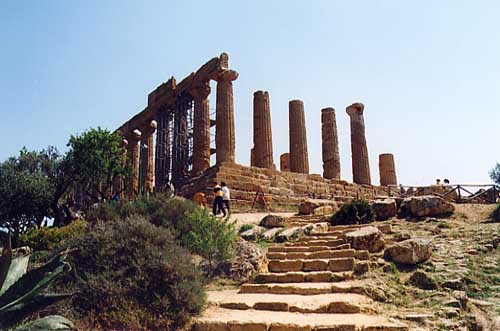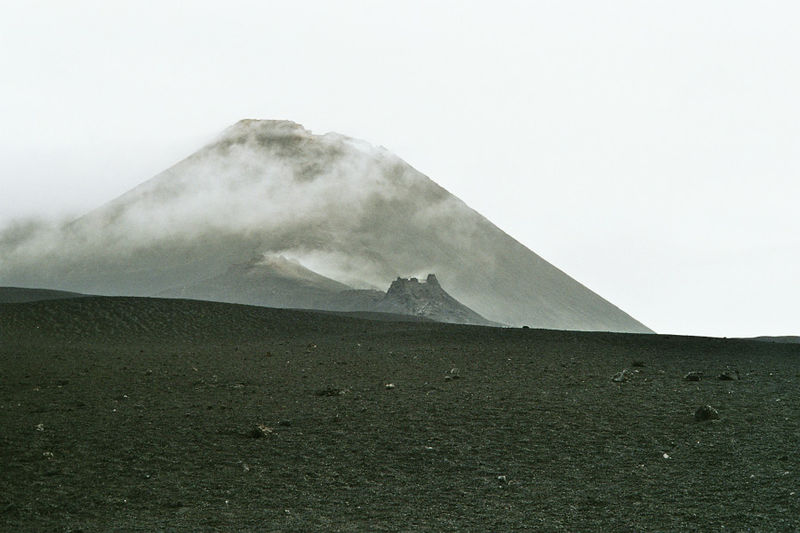<Back to Index>
- Philosopher Empedocles (Εμπεδοκλής), 490 B.C.
PAGE SPONSOR
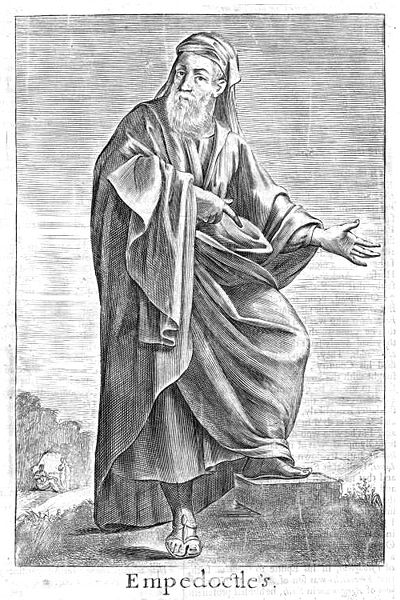
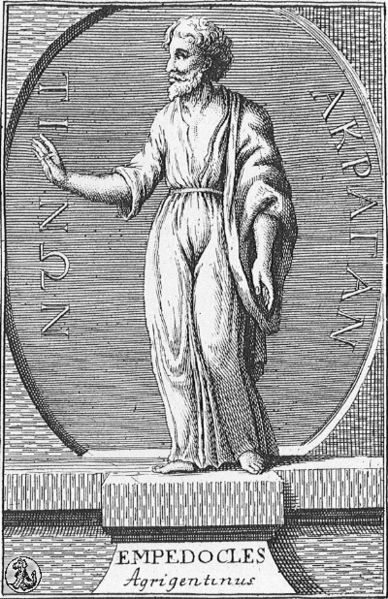
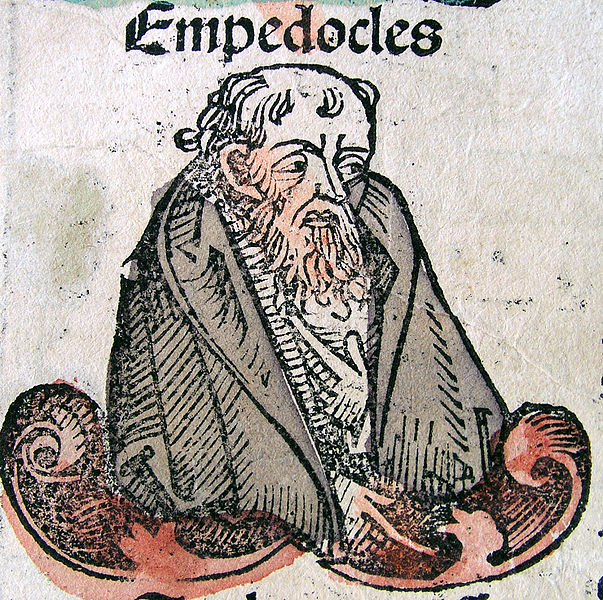
Empedocles (Ancient Greek: Ἐμπεδοκλῆς; ca. 490 – 430 BC) was a Greek pre-Socratic philosopher and a citizen of Agrigentum, a Greek city in Sicily. Empedocles' philosophy is best known for being the originator of the cosmogenic theory of the four Classical elements. He also proposed powers called Love and Strife which would act as forces to bring about the mixture and separation of the elements. These physical speculations were part of a history of the universe which also dealt with the origin and development of life. Influenced by the Pythagoreans, he supported the doctrine of reincarnation. Empedocles is generally considered the last Greek philosopher to record his ideas in verse. Some of his work survives, more than in the case of any other Presocratic philosopher. Empedocles' death was mythologized by ancient writers, and has been the subject of a number of literary treatments.
Empedocles was born, c. 490 BC, at Agrigentum (Acragas) in Sicily to a distinguished family. Very little is known about his life. His father Meto seems to have been instrumental in overthrowing the tyrant of Agrigentum, presumably Thrasydaeus in 470 BC. Empedocles continued the democratic tradition of his house by helping to overthrow the succeeding oligarchic government. He is said to have been magnanimous in his support of the poor; severe in persecuting the overbearing conduct of the aristocrats; and he even declined the sovereignty of the city when it was offered to him.
His brilliant oratory, his penetrating knowledge of nature, and the reputation of his marvellous powers, including the curing of diseases, and averting epidemics, produced many myths and stories surrounding his name. He was said to have been a magician and controller of storms, and he himself, in his famous poem Purifications seems to have promised miraculous powers, including the destruction of evil, the curing of old age, and the controlling of wind and rain.
Empedocles was acquainted or connected by friendship with the physicians Acron and Pausanias, who was his eromenos; with various Pythagoreans; and even, it is said, with Parmenides and Anaxagoras. The only pupil of Empedocles who is mentioned is the sophist and rhetorician Gorgias.
Timaeus and Dicaearchus spoke of the journey of Empedocles to the Peloponnese, and of the admiration which was paid to him there; others mentioned his stay at Athens, and in the newly founded colony of Thurii, 446 BC; there are also fanciful reports of him travelling far to the east to the lands of the Magi.
According to Aristotle, he died at the age of sixty, (c. 430 BC) even though other writers have him living up to the age of one hundred and nine. Likewise, there are myths concerning his death: a tradition, which is traced to Heraclides Ponticus, represented him as having been removed from the Earth; whereas others had him perishing in the flames of Mount Etna. A contemporary Life of Empedocles by Xanthus has been lost.
Empedocles
is considered the last Greek philosopher to write in verse and the
surviving fragments of his teachings are from two poems, Purifications and On Nature. Empedocles was undoubtedly acquainted with the didactic poems of Xenophanes and Parmenides -
allusions to the latter can be found in the fragments, - but he seems
to have surpassed them in the animation and richness of his style, and
in the clearness of his descriptions and diction. Aristotle called him the father of rhetoric, and, although he acknowledged only the meter as a point of comparison between the poems of Empedocles and the epics of Homer, he described Empedocles as Homeric and powerful in his diction. Lucretius speaks of him with enthusiasm, and evidently viewed him as his model. The two poems together comprised 5000 lines. About
550 lines of his poetry survive, although because ancient writers
rarely mentioned which poem they were quoting, it is not always certain
to which poem the quotes belong. Some scholars now believe that there
was only one poem, and that the Purifications merely formed the beginning of On Nature.
We possess only about 100 lines of his Purifications. It seems to have given a mythical account of the world which may, nevertheless, have been part of Empedocles' philosophical system. The first lines of the poem are preserved by Diogenes Laërtius:
Friends who inhabit the mighty town by tawny Acragas
which crowns the citadel, caring for good deeds,
greetings; I, an immortal God, no longer mortal,
wander among you, honoured by all,
adorned with holy diadems and blooming garlands.
To whatever illustrious towns I go,
I am praised by men and women, and accompanied
by thousands, who thirst for deliverance,
some ask for prophecies, and some entreat,
for remedies against all kinds of disease.
It was probably this work which contained a story about souls, where we are told that there were once spirits who lived in a state of bliss, but having committed a crime (the nature of which is unknown) they were punished by being forced to become mortal beings, reincarnated from body to body. Humans, animals, and even plants are such spirits. The moral conduct recommended in the poem may allow us to become like gods again.
There are about 450 lines of his poem On Nature extant, including 70 lines which have been reconstructed from some papyrus scraps known as the Strasbourg Papyrus. The poem originally consisted of 2000 lines of hexameter verse, and was addressed to Pausanias. It
was this poem which outlined his philosophical system. In it,
Empedocles explains not only the nature and history of the universe,
including his theory of the four classical elements,
but he describes theories on causation, perception, and thought, as
well as explanations of terrestrial phenomena and biological processes.
Although acquainted with the theories of the Eleatics and the Pythagoreans, Empedocles did not belong to any one definite school. An eclectic in his thinking, he combined much that had been suggested by Parmenides, Pythagoras and the Ionian schools. He was both a firm believer in Orphic mysteries, as well as a scientific thinker and a precursor of physical science. Aristotle mentions Empedocles among the Ionic philosophers, and he places him in very close relation to the atomist philosophers and to Anaxagoras.
Empedocles, like the Ionian philosophers and the atomists, tried to find the basis of all change. They did not, like Heraclitus, consider coming into existence and motion as the existence of things, and rest and tranquillity as the non - existence. This is because they had derived from the Eleatics the conviction that an existence could not pass into non - existence, and vice versa. In order to allow change to occur in the world, against the views of the Eleatics, they viewed changes as the result of mixture and separation of unalterable substances. Thus Empedocles said that a coming into existence from a non - existence, as well as a complete death and annihilation, are impossible; what we call coming into existence and death is only mixture and separation of what was mixed.
It was Empedocles who established four ultimate elements which make all the structures in the world - fire, air, water, earth. Empedocles called these four elements "roots", which, in typical fashion, he also identified with the mythical names of Zeus, Hera, Nestis, and Aidoneus. Empedocles never used the term "element" (Greek: στοιχεῖον) (stoicheion), which seems to have been first used by Plato. According to the different proportions in which these four indestructible and unchangeable elements are combined with each other the difference of the structure is produced. It is in the aggregation and segregation of elements thus arising, that Empedocles, like the atomists, found the real process which corresponds to what is popularly termed growth, increase or decrease. Nothing new comes or can come into being; the only change that can occur is a change in the juxtaposition of element with element. This theory of the four elements became the standard dogma for the next two thousand years.
The four elements are, however, simple, eternal, and unalterable, and as change is the consequence of their mixture and separation, it was also necessary to suppose the existence of moving powers - to bring about mixture and separation. The four elements are eternally brought into union, and eternally parted from each other, by two divine powers, Love and Strife. Love (Greek: φιλία) explains the attraction of different forms of matter, and Strife (Greek: νεῖκος) accounts for their separation. If the elements are the content of the universe, then Love and Strife explain their variation and harmony. Love and Strife are attractive and repulsive forces which the ordinary eye can see working amongst people, but which really pervade the universe. They alternately hold empire over things, - neither, however, being ever quite absent.
As the best and original state, there was a time when the pure elements and the two powers co-existed in a condition of rest and inertness in the form of a sphere. The elements existed together in their purity, without mixture and separation, and the uniting power of Love predominated in the sphere: the separating power of Strife guarded the extreme edges of the sphere. Since that time, strife gained more sway and the bond which kept the pure elementary substances together in the sphere was dissolved. The elements became the world of phenomena we see today, full of contrasts and oppositions, operated on by both Love and Strife. The sphere being the embodiment of pure existence is the embodiment or representative of god. Empedocles assumed a cyclical universe whereby the elements return and prepare the formation of the sphere for the next period of the universe.
Since
the time of the sphere, Strife has gained more sway; and the actual
world is full of contrasts and oppositions, due to the combined action
of both principles. Empedocles attempted to explain the separation of
elements, the formation of earth and sea, of Sun and Moon, of
atmosphere. He also dealt with the first origin of plants and animals,
and with the physiology of
humans. As the elements entered into combinations, there appeared
strange results - heads without necks, arms without shoulders. Then
as these fragmentary structures met, there were seen horned heads on
human bodies, bodies of oxen with human heads, and figures of double sex. But
most of these products of natural forces disappeared as suddenly as
they arose; only in those rare cases where the parts were found to be
adapted to each other, did the complex structures last. Thus the organic
universe sprang from spontaneous aggregations, which suited each other
as if this had been intended. Soon various influences reduced the
creatures of double sex to a male and a female, and the world was
replenished with organic life. It is possible to see this theory as an
anticipation of Darwin's theory of natural selection, although Empedocles was not trying to explain evolution.
Empedocles is credited with the first comprehensive theory of light and vision. He put forward the idea that we see objects because light streams out of our eyes and touches them. While flawed in hindsight, this became the fundamental basis on which later Greek philosophers and mathematicians, such as Euclid, would construct some of the most important theories on light, vision and optics.
Knowledge is explained by the principle that the elements in the things outside us are perceived by the corresponding elements in ourselves. Like is known by like. The whole body is full of pores, (and hence respiration takes place over the whole frame). In the organs of sense these pores are specially adapted to receive the effluences which are continually rising from bodies around us; and in this way perception is explained. Thus in vision, certain particles go forth from the eye to meet similar particles given forth from the object, and the resultant contact constitutes vision. Perception is not merely a passive reflection of external objects.
Empedocles noted the limitation and narrowness of human perceptions. We see only a part, but fancy that we have grasped the whole. But the senses cannot lead to truth; thought and reflection must look at the thing on every side. It is the business of a philosopher, while laying bare the fundamental difference of elements, to display the identity that exists between what seem unconnected parts of the universe.
In a famous fragment, Empedocles attempted to explain the phenomena of respiration by means of an elaborate analogy with the clepsydra, an ancient device for transmitting liquids from one vessel to another. This fragment has sometimes been connected to a passage in Aristotle's Physics where Aristotle refers to people who twisted wineskins and captured air in clepsydras to demonstrate that void does not exist. There is however, no evidence that Empedocles performed any experiment with clepsydras. The fragment certainly implies that Empedocles knew about the corporeality of air, but he says nothing whatever about the void. The clepsydra was a common utensil and everyone who used it must have known, in some sense, that the invisible air could resist liquid.
Like Pythagoras, Empedocles believed in the transmigration of the soul, that souls can be reincarnated between humans, animals and even plants. For
Empedocles, all living things were on the same spiritual plane; plants
and animals are links in a chain where humans are a link too. Empedocles
urged a vegetarian lifestyle, since the bodies of animals are the dwelling places of punished souls. Wise people, who have learned the secret of life, are next to the divine, and their souls, free from the cycle of reincarnations, are able to rest in happiness for eternity.
Diogenes Laërtius records the legend that he died by throwing himself into an active volcano (Mount Etna in Sicily), so that people would believe his body had vanished and he had turned into an immortal god; the volcano, however, threw back one of his bronze sandals, revealing the deceit. Another legend maintains that he threw himself into the volcano to prove to his disciples that he was immortal; he believed he would come back as a god among men after being devoured by the fire.
In Icaro - Menippus, a comedic dialogue written by the second century satirist Lucian of Samosata, Empedocles’ final fate is re-evaluated. Rather than being incinerated in the fires of Mount Etna, he was carried up into the heavens by a volcanic eruption. Although a bit singed by the ordeal, Empedocles survives and continues his life on the Moon, surviving by feeding on dew.
Empedocles' death has inspired two major modern literary treatments. Empedocles' death is the subject of Friedrich Hölderlin's play Tod des Empedokles (Death of Empedocles), two versions of which were written between the years 1798 and 1800. A third version was made public in 1826. In Matthew Arnold's poem Empedocles on Etna, a narrative of the philosopher's last hours before he jumps to his death in the crater first published in 1852, Empedocles predicts:
- To the elements it came from
- Everything will return.
- Our bodies to earth,
- Our blood to water,
- Heat to fire,
- Breath to air.
In 2006, a massive underwater volcano off the coast of Sicily was named Empedocles.
